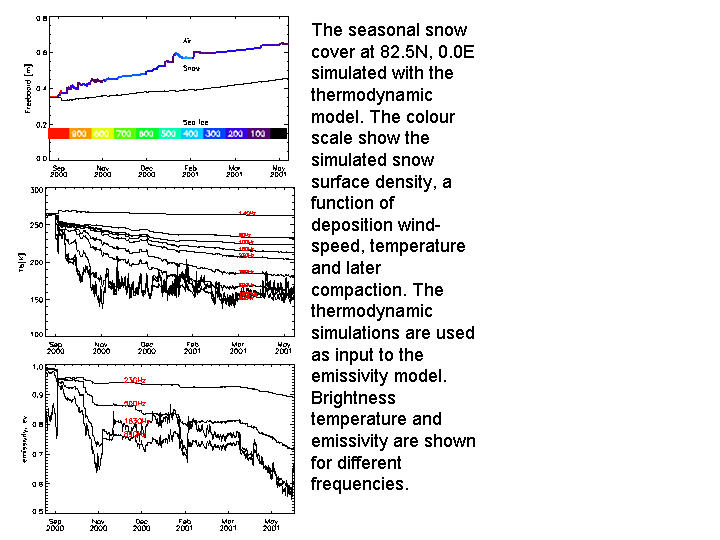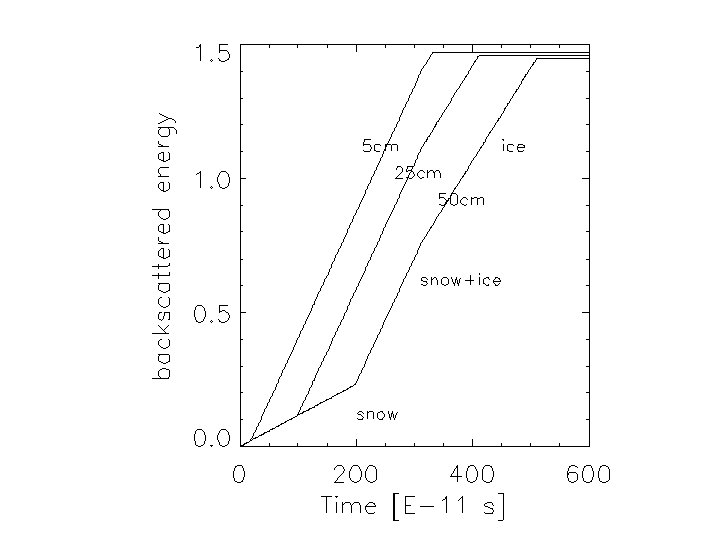Sea ice forward modelling
Forward models relate the physical properties of the snow and ice with
the microwave thermal emission or backscatter. The models are used:
1) in sensitivity studies, where the microwave signature sensitivity to different physical properties can be simulated,
2) model inversion to derive snow or ice parameters, where the model
with its physical input is fitted to a measured signature, or
3) forward modelling to estimate a surface signature using simulated physical input.
Both the backscatter and emission models are reseach level model with a
rather large number of input parameters. Some of these parameters are
rarely measured in the field and/or difficult to measure properly e.g.
surface roughness. Anyway the models are applied for both
sensitivity studies and model inversion in research projects.
Sea ice microwave emissivity
The microwave brightness temperature of a lossy half-space such as snow
and sea ice is the product of the effective temperature and the
emissivity. The effective temperature is the integrated emitting layer
thermometric temperature. During winter the surface skin temperature is
usually lower than the effective temperature. The emissivity at a
certain polarisation, frequency and angle is a function of subsurface
extinction and reflections between layers with different permittivity.
These parameters and processes are described in the emission model. We
use aand develop a sea ice version of Microwave Emission Model
for Layered Snowpacks (MEMLS). MEMLS treating the processes for fresh
snow on any given surface is described in Wiesmann & Mätzler,
RSE 70: 307-316 (1999). The sea ice version is described in
Mätzler et al. (eds) Thermal microwave radiation - Applications
for Remote Sensing, IEE Electromagnetic Wave Series, 2006.
Brightness temperature and emissivity simulations
Input to the forward model is a stack of layers with information about:
temperature, layer thickness, grain or inclusion sizes, salinity,
liquid water content for each layer. These parameters can be
measured in snow pits and by ice coring or they can be simulated using
thermodynamic models. Earlier studies with snowpacks on land indicate
that the thermodynamic models tend to underestimate the sharp desity
contrasts between snow layers. This may also be a problem in snow pits
since snow layers on sea ice are often thin and the snow cover often
only 10-20cm thick. Smal scale spatial variability is difficult to
characterise with both methods. Regional climatic differences and
interchannel correlations may be characterised in thermodynamic
models using seasonal simulations.

Radar altimeter backscatter modelling
The backscatter coefficient for a space-borne altimeter system of snow
free, level sea ice is primarily a function of ice roughness and
coherent surface scattering surface scattering mechanisms witin the
snow/ice system. Attenuation together with volume scattering detirmines
the exinction of the propagating signal within the snow and ice layers.
Nadir backscatter of snow covered sea ice is dominated by ice surface
surface scattering. Yet the link between the prominent scattering
horisons and the effective scattering surface, when the altimeter is
used for surface elevation measurements, is unclear. These issues are
important for the success of the upcoming CryoSat. A theoretical
prediction is given using a backscatter model. The model is described
in Tonboe et al. IEEE GRSL 3(2): 237-240. A gnu-octave (similar to
matlab) version of the model can be downloaded here (tar-file).
Read more (pdf):
Tonboe, R. T., S. Andersen, R. S. Gill, L. Toudal Pedersen. The simulated seasonal variability of the Ku-band radar altimeter effective scattering surface depth in sea ice.
In: Wadhams & Amanatidis (Eds.) Arctic Sea Ice Thickness: past,
present and future. Climate change and natural hazards series 10, EUR
22416, 2007.
The figure show the simulated leading edge of the multiyear ice pulse
form for different snow cover depths. The curve to the left is for the
5-cm snow cover, the middle curve the 25-cm snow cover and the right
curve the 50-cm snow cover.

Collaboration
The models were developed in the former EU projects IOMASA lead by
Georg Heygster and GreenICE lead by Peter Wadhams developments are
still ongoing in the EU contribution to IPY DAMOCLES project lead by
J.-C. Gascard.

